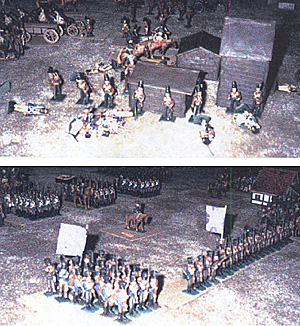Historical background:
"The battle at Leipzig was to be the largest battle in history to that date. The combined might of the allied and French armies were about to meet and decide the fate of Europe for the next 150 years.
The allied forces initially on the battlefield consisted of the Army of Bohemia, to the south, and the Army of Silesia, to the north. They were to be joined later by the Army of Poland and the Army of the North. Total Allied Armies present 351,540 men and 1.314 guns. Napoleon's Army consisted of 191,455 men and 752 guns.
The battle of Leipzig would see 542,995 men locked in combat for four days. It would be the climax of the 1813 fall campaign and the battle that finally broke the power of Napoleon's Empire" (Nafziger, G.F, Napoleon at Leipzig. Chicago, 1996, pp.100-101.)
Forces available:
For reasons of space and time we decided to wargame only the right flank of the battle of Wachau 16 October 1813. The following forces were deployed in accordance with historical maps of Wachau, Liebertwolkwitz and Mark-Kleeberg:
French: 31 battalions, 7 cavalry regiments, 7 guns
Allies: 39 battalions, 10 cavalry regiments, 6 guns, including:
Austrians: 12 battalions, 3 cavalry regiments, 3 guns
Russians: 7 battalions, 3 cavalry regiments, 1 gun
Prussians: 20 battalions, 4 cavalry regiments, 2 guns
French: 638 figures (564 infantry, 94 cavalry)
Allies: 920 figures (814 infantry, 106 cavalry) including:
Austrians: 342 figures (302 infantry, 40 cavalry)
Russians: 128 figures (112 infantry, 16 cavalry)
Prussians: 450 figures (400 infantry, 50 cavalry)
Generals:
French side:
Marechal d'Empire Victor – Nikolai Semibratov
General de Division Marchand – Craig Martelle
Allied side:
Feldmarschal-leutnant Gyulai – Maxim Veretelnikov
General Bulow – Aleksei Razigraev
Disposition:
Austrians were deployed on the right allied flank in front of Liebertwolkwitz village. Prussian Corps stood in the center and Russians were on the left against Mark-Kleeberg. All forces stood in battalion columns with cavalry and artillery in close support. Some reserves were visible on the extreme Austrian right.
French forces strongly occupied Wachau and Liebertwolkwitz and had two heavy cavalry brigades in central reserve. Battalion columns were supported by light infantry skirmishers and divisional artillery. Division of General Marchand was deployed on the French right. It consisted of Baden and Hessian troops.
The battle:
The battle began with strong Austrian attack against Liebertwolkwitz village. After hard fighting French defenders were thrown out with bayonets and one of their eagles was captured. Austrian skirmishers occupied the village killed some French officers in French ranks and two generals from divisional staff. The situation on the French left was critical. They were saved only by immobility of the whole Allied center (20 Prussian battalions). French player took some units from his own center and reinforced his left. Prussians were only spectators. By unknown reasons they moved to attack only on the second day and very cautiously.
Russians manoeuvred with their cossacks and bombarded Hessian battalions with their 12pdr. Heavy losses were inflicted on some Hessian units.
On the second day French reserve of 2 heavy brigades were thrown in attack to reestablish situation on the left flank. Liebertwolkwitz was recaptured and Austrians began their retreat.
Prussian center tried to attack Wachau but without result.
Losses:
French: 130 figures
Allies: 134 figures, including
Austrians: 60 figures
Russians: 33 figures
Prussians: 41 figures
Austrians captured the Eagle of the 2e d'Infanterie de Ligne.
 Right Above: Defense of Wachau.
Right Above: Defense of Wachau.
Below: The Prussians are lined up for the attack.
The figures are made from Plastolin by Nikolai Semibratov & Alexei Rozygraev. They are 40mm in scale, and completely historically accurate. The game uses live shooting to replicate the hit/miss charts - the variables lie in how far away the shot is taken from and how many rounds per volley are allowed.
The rules are very strict regarding the use of column, square, and line. The cavalry is also under tight control and can be quickly destroyed should they attack a prepared target.
Back to The Gauntlet No. 20 Table of Contents
Back to The Gauntlet List of Issues
Back to Master Magazine List
© Copyright 2000 by Craig Martelle Publications
This article appears in MagWeb (Magazine Web) on the Internet World Wide Web.
Other military history articles and gaming articles are available at http://www.magweb.com